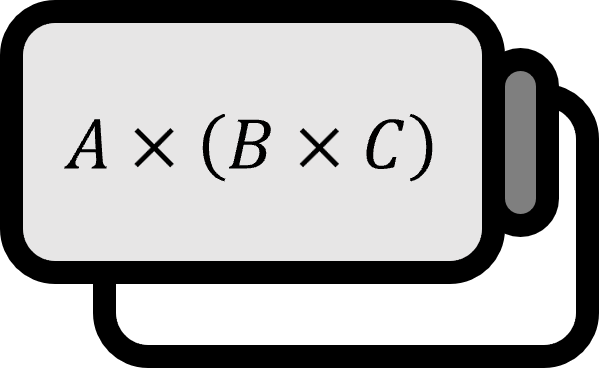What is the Dot Product in Three-Dimensional Space?
Definition
The inner product of two 3-dimensional vectors $\mathbf{A} = (A_{x}, A_{y}, A_{z})$ and $\mathbf{B} = (B_{x}, B_{y}, B_{z})$ is defined as follows.
$$ \mathbf{A} \cdot \mathbf{B} := A_{x}B_{x} + A_{y}B_{y} + A_{z}B_{z} $$
Description
In fact, the above definition specifically refers to the dot product. The term inner product is a translation of inner product, which is often used to refer to a more general concept. However, in high school or physics classes, it is commonly just referred to as the inner product. Because the result of the calculation is a scalar (a constant), it is also called the scalar product.
Notation
Each component’s subscript is commonly notated with numbers as follows with the $\sum$ symbol.
$$ \mathbf{A} \cdot \mathbf{B} = A_{1}B_{1} + A_{2}B_{2} + A_{3}B_{3} = \sum_{i=1}^{3} A_{i}B_{i} = \delta_{ij}A_{i}B_{j} $$
Here, $\delta_{ij}$ refers to the Kronecker delta.
Properties
Let $\left| \mathbf{A} \right| = \sqrt{A_{x}^{2} + A_{y}^{2} + A_{z}^{2}}$ be the magnitude of vector $\mathbf{A}$, and let $\theta$ be the angle between vectors $\mathbf{A}$ and $\mathbf{B}$. Then the following holds: $$ \mathbf{A} \cdot \mathbf{B} = \left| \mathbf{A} \right| \left| \mathbf{B} \right| \cos\theta $$
For two vectors $\mathbf{A}$ and $\mathbf{B}$ that are perpendicular to each other, $$ \mathbf{A} \cdot \mathbf{B} = 0 $$
Magnitude of a vector: $\left| \mathbf{A} \right| = \sqrt{\mathbf{A} \cdot \mathbf{A}}$
Commutative law: $\mathbf{A} \cdot \mathbf{B} = \mathbf{B} \cdot \mathbf{A}$
Distributive law over addition: $\mathbf{A} \cdot (\mathbf{B} + \mathbf{C}) = \mathbf{A} \cdot \mathbf{B} + \mathbf{A} \cdot \mathbf{C}$
